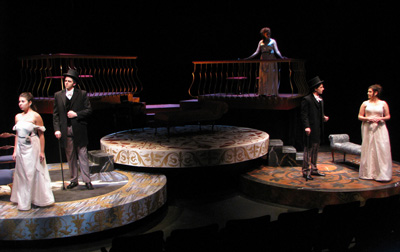By David Gordon
There’s no simple way to describe “Camille,” Robert David MacDonald’s drama, currently being performed at the Black Box Theater in Hofstra’s New Academic Building. The play is an exciting enigma-a work which combines three versions of the same story and has each performed simultaneously.
“Camille” began as a novel, “The Lady of the Camellias,” by Alexandre Dumas, fils (the younger). Based upon his relationship with Marie Duplessis, a French courtesan, Dumas later adapted his highly successful novel into an even more successful play, “Camille.” Giuseppe Verdi took note, and shortly after, turned it into one of his seminal works, “La Traviata.” Greta Garbo starred in one of the many film versions of the play. Recent audiences are most familiar with the work under a different title: “Moulin Rouge.”
Robert David MacDonald’s play juxtaposes scenes from “La Traviata” and “Camille” (the play), as well as what he believes to have actually gone on between Alexandre Dumas (Ariya Ghahramani) and Marie Duplessis (Nikki Dillon). The names changed in the opera to Violetta (Elisa Pasqua) and Alfredo (J.C. Laws), and further changed in the play to Marguerite (Kelly Wadler) and Armand (Ben Myers), all of whom appear on stage in this production.
The result? On one side of the stage, two characters sing the romantic score of Verdi; on the other, two characters act out the same story using the words of Dumas’ play; and in the center, a variety of characters act out “the real thing,” a much less romanticized and significantly more difficult to watch version of the three.
It’s an ambitious work, one that has only been performed four times prior to James J. Kolb’s staging at the Black Box. This is the American premiere of the play (which has never been published). Kolb’s staging doesn’t disappoint. “Camille” is an incredible production.
The cast is uniformly strong. Matt Weaver as Gaston (Marie’s gay accomplice), and Jillian Sorgini as Cupidon (Marie’s servant), know how to nail a punch line perfectly. Chris D’Amato and Adam Burgess are wonderfully creepy as two of Marie’s patrons-the Baron and the Duke. Jordan Hue is very strong as the seemingly flamboyant Doctor Korev.
One would be reluctant to say Myers and Wadler have it the easiest (since nothing in the show is easy), but it seems that of the six leads, they have the least strenuous part. Their delightful chemistry brings a lilt to Dumas’ seemingly esoteric text.
Elisa Pasqua and J.C. Laws (a Hofstra graduate and guest artist in the production), accompanied on the piano by musical director Eric Baum, manage to make the traditionally exaggerated performances of opera singers seem less over-the-top. And their voices are divine.
Personality-wise, Ghahramani is a suitably awkward Alexandre, though perhaps a bit too awkward physically. He walks around the stage slightly hunched over, like life has defeated him long before it had a chance to get started.
Arguably, Dillon has the heaviest lifting throughout the show. She looks spent by the curtain call, and for good reason. Her devastating performance was so real that it is frightening.
David Zyla’s regal costumes were period-perfect and splendid to look at, as were David Henderson’s gorgeously grandiose three-level set (complete with paintings on each level) and Matt Rubin’s luscious lighting.
With multiple conversations going on at the same time (and lines often repeated by each character) Robert MacDonald’s script is an incredibly difficult read. James Kolb’s skilled direction makes a seemingly confusing play not at all hard to comprehend.
With a violent death scene, partial nudity, and strong, seemingly off-putting sexual content, Kolb has staged the show with a gruesome, no-holds-barred attitude. The result is a haunting, cathartic experience.
By the final blackout, “Camille” leaves you with the feeling of being punched in the stomach-you’re gasping for air but have no way to catch your breath. And we, as an audience, are forever changed. It is an incredible accomplishment for Kolb and the very talented students of the department of drama and dance. Perhaps we’ll see more of these daring works in the future.

From left, Elisa Pasqua, Charles Rohlfs, Nikki Dillon, Benjamin Pike and Kelly Wadler on the three separate stages used in “Camille.” (Rychard L. Curtiss)
